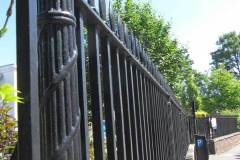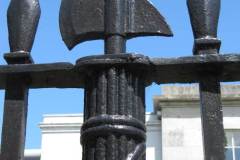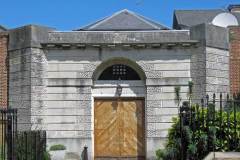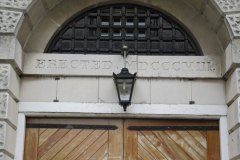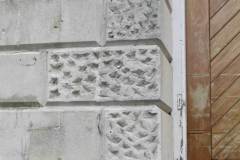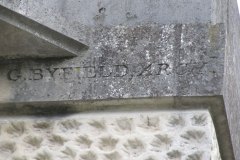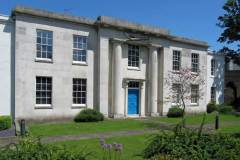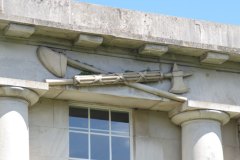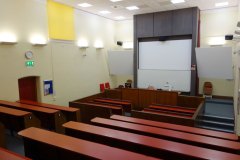Canterbury gaol (closed 2013 and now part of Christ Church University) and Sessions House (also part of Christ Church University) stand side by side in Longport. Both were constructed in 1808, and they are linked by an underground tunnel – now blocked up. A single run of original iron railings with distinctive repeated features of fasces (bundles of wooden rods) and protruding axe heads, embraces both sites. Fasces and the axe have been used as symbols of authority and power since ancient Roman times. (Fasces can also be seen on the facade of the former Debenham’s store in Guildhall Street.)
Gaol
The gaol was opened in 1808 as the new ‘County gaol and House of Correction’. It took over from the county gaol in St Dunstan’s. The removal of prisoners from St Dunstan’s to the new premises at 5 AM on 14 December 1808, linked by handcuffs and chains, did not go well as the ‘caravan’ of inmates arrived with one member missing. John Betts, alias George Wise, a 17 year old petty thief, had managed to slip his hand through his cuffs, and given himself an early Christmas surprise by disappearing into the Canterbury streets. The new prison building was designed by the architect George Byfield (his name is carved on the front of the building) and completed at a cost £15,333. It was built on land which had previously formed part of the lands of St Augustine’s monastery, designed on the ‘radiating plan’ advocated by the philosopher and social reformer Jeremy Bentham. The facade is suitably bold and stern, with heavy stone rustication, a grilled lunette, and two imposing bastions. The surrounding security wall is 20 feet high. One visitor to the gaol in 1813 was Jane Austen, who arrived with her brother Edward, then a visiting magistrate. A return of the 1860s shows it housing 152 male and 14 female prisoners in 132 cells. By then it was equipped with gas lighting and a treadmill. The latter, unlike some prisons where the mill was installed only as punishment, in Canterbury served the useful function of pumping water. Inmates also worked on the picking of oakum (tarred fibres), tailoring, shoemaking, and growing vegetables in the prison garden. The prison marked its 200th anniversary with a visit by Princess Anne in July 2008, but was closed down in March 2013.
Sessions House
The Sessions House has been described as a ‘Greek revival cubic mass’. It is faced in Portland stone, dominated by giant Doric columns. Like the prison it shows oversized mutules (the rectangular blocks which appear to support the roof and parapet). Above the original entrance, images in stone represent more fasces with axe, here crossed with a pole and cap of liberty. The symbolism supposedly suggests order with freedom. In 1998 the restored building opened as part of Canterbury Christ Church University. The sensitive conversion of the original court by local architect David Coupe won awards from RIBA and from the Canterbury Conservation Advisory Committee. It included creation of a two storey rotunda, and cost £3 million overall.
What to see:
- original railings with fasces and axe features extending across both prison and Sessions House sites (Image 1)
- detail of fasces and axe motifs (Image 2)
- prison entrance with text above ‘County gaol and House of Correction’ (Image 3)
- prison entrance showing lunette grill and erection date 1808 (Image 4)
- prison entrance rustication in stonework (Image 5)
- prison entrance showing name of architect (Image 6)
- Sessions House overview (Image 7)
- Sessions House images above doorway (Image 8)
- restored Sessions House lecture room (Image 9)
PS If you’re wondering what became of John Betts, the Kentish Gazette (20 December 1808) advertised ‘a reward of five guineas and all reasonable expenses upon delivering him into the custody of the Keeper’ of the new prison. John was described as ‘a labouring man, aged about 17 years, light brown hair cut short, thin made, about 5 ft 4 inches high, a native of Dover. I’ve found no evidence that the reward was ever claimed – click here for related PDF.
Sources: Cantacuzino (1970); Chalkin (1998) for cost of construction; Hampshire Chronicle 26 December 1808 for the escape of John Betts; Kent Gazette 6 May 1808 for opening of prison; also Reports on Prisons (1863); for restoration of the Sessions House see CCCU press notice of 20 September 2000.

